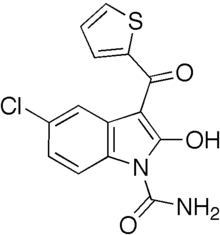Tenidap
Tenidap was a COX/5-LOX inhibitor and cytokine-modulating anti-inflammatory drug candidate[1] that was under development by Pfizer as a promising potential treatment for rheumatoid arthritis,[2] but Pfizer halted development after marketing approval was rejected by the FDA in 1996[3] due to liver and kidney toxicity, which was attributed to metabolites of the drug with a thiophene moiety that caused oxidative damage.[4]
 | |
| Clinical data | |
|---|---|
| ATC code | |
| Identifiers | |
| |
| CAS Number | |
| PubChem CID | |
| ChemSpider | |
| UNII | |
| KEGG | |
| ChEMBL | |
| CompTox Dashboard (EPA) | |
| Chemical and physical data | |
| Formula | C14H9ClN2O3S |
| Molar mass | 320.75 g·mol−1 |
| 3D model (JSmol) | |
| |
| |
| | |
References
- Wylie G, Appelboom T, Bolten W, Breedveld FC, Feely J, Leeming MR, et al. (June 1995). "A comparative study of tenidap, a cytokine-modulating anti-rheumatic drug, and diclofenac in rheumatoid arthritis: a 24-week analysis of a 1-year clinical trial". British Journal of Rheumatology. 34 (6): 554–63. doi:10.1093/rheumatology/34.6.554. PMID 7543348.
- Staff, American Journal of Nursing. Drug Watch: Tenidap Offers Arthritis Therapy Minus Toxicity AJN 1996 96(1):58
- Pfizer. Sept 27, 1996 Press release: Pfizer To Halt Plans For Commercialization Of Tenidap For Rheumatoid Arthritis
- Hwang SH, Wecksler AT, Wagner K, Hammock BD (2013). "Rationally designed multitarget agents against inflammation and pain". Current Medicinal Chemistry. 20 (13): 1783–99. doi:10.2174/0929867311320130013. PMC 4113248. PMID 23410172.
This article is issued from Wikipedia. The text is licensed under Creative Commons - Attribution - Sharealike. Additional terms may apply for the media files.